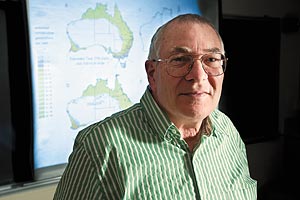Predicting the future spread of infectious-disease vectors
As global warming raises concerns about potential spread of infectious diseases, a team of researchers has demonstrated a way to predict the expanding range of human disease vectors in a changing world.

Professor of Zoology, Warren Porter stands in front of a projected map of Australia showing possible future habitat for the mosquito that carries dengue fever. Using software models to predict the spread of the human disease vector, Porter’s research team has found that a combination of climate change, evolutionary change and human behavior are likely to expand the mosquito’s range over the next 40 years, increasing the risk of disease transmission.
Photo: Bryce Richter
Researchers from Australia and UW–Madison have identified the key biological and environmental factors constraining a population of the dengue fever vector, the mosquito Aedes aegypti. In a study publishing online Jan. 28 in the British Ecological Society’s journal Functional Ecology, they report that climate changes in Australia during the next 40 years and the insect’s ability to adapt to new conditions may allow the mosquitoes to expand into several populated regions of the continent, increasing the risk of disease transmission.
While the current study focuses on the Australian population of the dengue mosquito, these mosquitoes live around the world and present a global threat similar in scope to malaria, according to the Centers for Disease Control and Prevention. Study author and UW–Madison zoologist Warren Porter says that the Australian findings are likely to apply to other worldwide mosquito populations as well.
Porter and his colleagues, led by Michael Kearney at the University of Melbourne, used software models to predict future mosquito habitat. Called Niche Mapper, the models use basic characteristics of an animal’s body, metabolic needs and behaviors to determine where that animal can live and reproduce successfully.
“Where would a species with a particular set of properties best survive and function on our planet?” asks Porter, who developed the Niche Mapper software with Madison and Australian colleagues. “By answering this question, we are able not only to calculate what the current distributions are, but even identify places where they might flourish where they don’t currently exist.”
Currently, dengue mosquitoes in Australia are restricted to Queensland in the northeast. However, the new work shows that climate changes predicted by 2050 will increase suitable mosquito habitat across much of the continent.
Of even greater concern, they say, are changes in human water-storage practices that are being driven by reduced rainfall in some cities. Mosquitoes lay their eggs in water, and much of the dengue mosquito’s favored breeding habitat is inadvertently provided by humans in the form of rainwater tanks and other open water containers. The study suggests that simple changes such as reducing or covering such tanks could counteract some of the climate change-driven habitat expansion.
However, the researchers also found a marked effect of something humans have less control over: the mosquito’s potential for evolutionary change. In fact, the ability to account for such an effect sets this model apart from all others.
“All biological systems are adaptive,” Porter says. “We have the capacity to not only look at climate change but at animal change as well.”
Because of the importance of watery breeding sites, the scientists focused on how well the insect’s eggs withstand desiccation during dry periods. By applying a model of rates of evolutionary change, they found that if the mosquitoes’ eggs develop an increased resistance to drying out — a trait that has evolved in related insects — the species could spread into larger areas of the continent.
The combined effects of climate change and evolution of resistance to egg desiccation were even more extensive. “When we put the two together there was a significant increase in the rate of expansion and in the distance and types of habitats they could occupy,” Porter says. “It’s only when you look at everything together that you can begin to say something about what is going to constrain the distribution of a species.”
Porter’s approach will also extend beyond mosquitoes. Because the Niche Mapper software uses basic properties of an animal, its requirements and its environment, the model is very versatile and can be applied to most any animal species living most anywhere on the planet. For example, Porter has used it to determine likely pesticide exposure levels of aquatic birds, potential patterns of spread of highly invasive species and the effects of global warming on reproductive success of the tuatara, a rare reptile.
In each instance, the trait-based format of the model allows researchers to pinpoint the most crucial factors for a given species. “Different species bring out different issues,” Porter says. “One of the remarkable things we have found consistently is that there aren’t a huge number of variables that really wag the tail on the dog, if you will. Usually there are only about three or four variables — such as air temperature, vegetation, diet quality, or water and energy requirements — that are critical, and they change depending on the species.”
Isolating the key factors for an individual species should help focus management efforts to handle the issues specific to that species, such as targeting potential breeding habitat to control mosquito populations. Porter recently started a company, Animaps, to make his modeling software available to researchers and government agencies and expand the range of applications.
“What we’ve done is to establish an approach to address this type of question,” he says. “Now we have the tools for being able to look at the spread of any vector-borne disease, whether it be carried by bird, mosquito or any other species.”
In addition to Porter and Kearney, the study was authored by Craig Williams of the University of South Australia, Scott Ritchie of James Cook University and Ary Hoffmann of the University of Melbourne.




